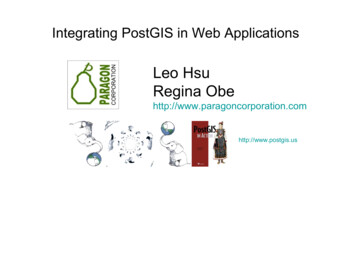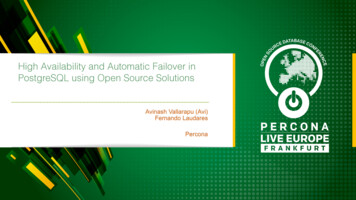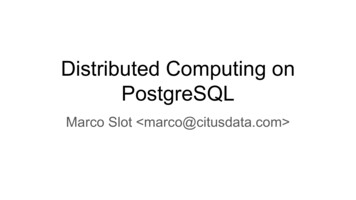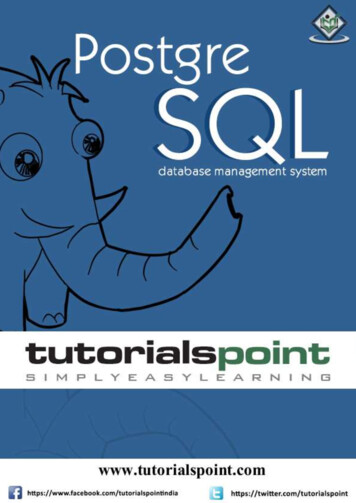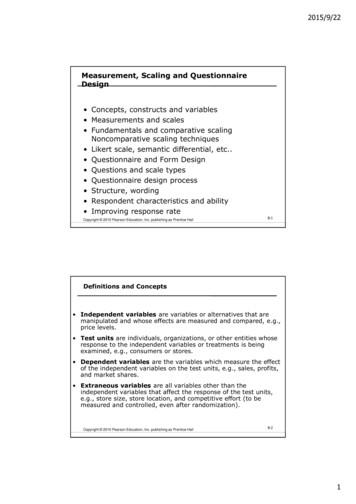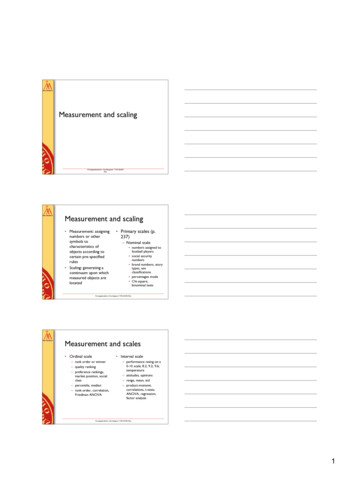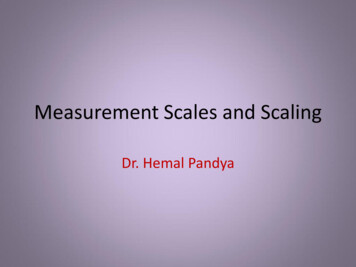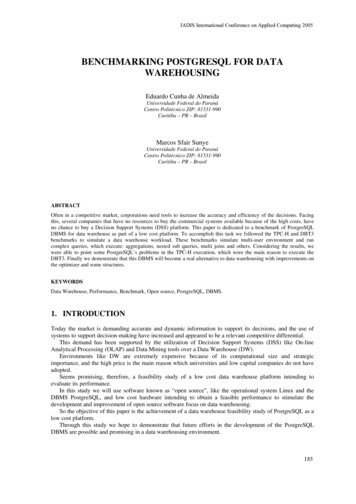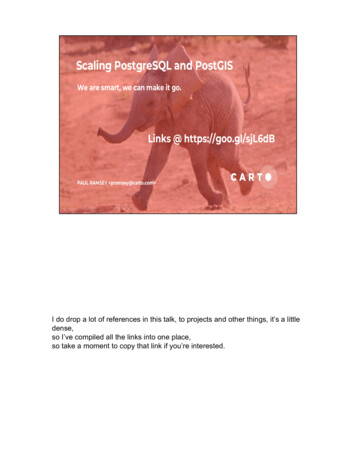
Transcription
Scaling PostgreSQL and PostGISWe are smart, we can make it go.Links @ https://goo.gl/sjL6dBPAUL RAMSEY pramsey@carto.com I do drop a lot of references in this talk, to projects and other things, it’s a littledense,so I’ve compiled all the links into one place,so take a moment to copy that link if you’re interested.
Hello spatial data scientists!I am an (old) GIS person.Links @ https://goo.gl/sjL6dBGreetings! I’ve been working with spatial data since the mid-1990s,initially within as a hands-on practitioner and then at increasing removesas I’ve gotten into tool building with projects like PostGIS and companies like Carto.
GIS data is theoriginal Big DataLinks @ https://goo.gl/sjL6dBAt the time I started, most vector spatial data was created using a rig like this,for manually capturing data off of aerial photo pairs.The British Columbia Ministry of Environmenthad recently completed a full mapping of the province at 1:20K scale,which is how we thought about things at the time:how much data would fit only an E-sized map sheet.But spatial data was beginning to become standard,and integrated into business systems,and it was clear that those systems were just not ready for it.It broke their core ideas about what a record of data was.
More than 1M vertices over 10MB in one polygon!The systems for managing the base map had to deal with what was called “theWilliston Lake problem”.Williston Lake is the 7th largest reservoir in the world.Mapped at 1:20K scale, and stitched together into a single polygonit was over 1M vertices: a single 10Mb polygon!This is not something you’d want to regularly transmit over a 10baseT ethernet link,let alone over the public internet connections of the time, or to a web browser of theperiod.How should you store and represent it?It’s two orders of magnitude bigger than the average lake polygon.
The Geospatial Big Data Challenge Float (4-8 bytes) 1DInteger (4-8 bytes) 1DDate (8-16 bytes) 1DString (1-1024 bytes) 1DGeometry (16-? bytes) NDLinks @ https://goo.gl/sjL6dBBusiness systems, and that includes databases,were built with the expectation that types were simple,and relatively small.Numbers and dates and text, not too big, all sortable on a 1 dimensional access,so indexable using simple btrees.Spatial data broke that, and broke it pretty badly.
Michael StonebrakerUC BerkeleyPostgres Ingres complex objects extensible robust active (triggers, user functions)Links @ https://goo.gl/sjL6dBFortunately, academia was way ahead of practice in government informationtechnology,so there was already work on managing complex objectsa decade before I first started trying to do it practice.Back in 1986, Michael Stonebraker wrote “The Design of Postgres”which laid out the goals for his latest research project.Postgres was to take the relational model and expand on it.Not just primitive types, also complex objects, and with run-time extension,so that anyone could code and add a new type.That’s what we did when we created PostGIS in 2000, we wrote a run-time extensionto Postgres.
PostgreSQL CoolRecently PostgreSQL has been “discovered” by the technology cool kids.The web devs.But being the “it” database is actually a pretty recent phenomenon.First it was MySQL’s older stodgier brother, and all the web devs worked with MySQL.Then it was NoSQL’s older slower brother, and all the web devs worked withMongoDB.But recently people have realized that a database that has a pedigree,that respects data integrity,that has a international development community andmore than one company behind it, is a valuable thing.It took 20 years to get there, but Postgres is finally getting the respect it deserves.
PostgreSQL EcosystemLocal Install OSX - postgress.app Windows - EnterpriseDB Linux - APT/YUM packages And Solaris, FreeBSD, HPUX, AIX and.And,A nice thing about a database with a history and a pedigree,there’s a big ecosystem around it.So a lot of things come easy.It’s nicely packaged on all major platforms,and lots of not-so-major ones.
PostgreSQL EcosystemCloud Services AWS RDS PostgreSQL Google Cloud SQL for PostgreSQL Azure Database for PostgreSQLAnd because it’s an industry standard,all the cloud vendors have now packaged it up as a managed service.So standing up a Postgres instance is as simple as stuffing in a credit card andclicking some web forms.All the Cloud providers include PostGIS support as well,Which, I think, is a testament tothe importance of spatial data,and spatial data analysis.
PostgreSQL Ecosystem3rd Party Connectivity Desktop admin toolsEvery language everQGIS desktopGDAL utilities and format libraryMapserver/Mapnik/GeoserverThe ecosystem includes lots of third-party tools,both for generic thingslike doing desktop data administration and programming language connectivity,and for specific things like working with spatial data.You can view and edit your PostgreSQL spatial data with QGIS,You can import/export it with GDAL,You can render it to web maps with Mapserver or Mapnik or Geoserver or others.
PostgreSQL EcosystemAdd-ons Scripting inside the database! PL/Python PL/R PL/V8 (aka JavaScript) PL/Perl PL/TCLStonebraker’s design vision included run-time extension,Low level hooks that allow new features to be added without changing the core code.One of those unique features is multiple language support.The ability to script within the database in multiple languages really cannot beundersold.Here at Carto we’ve leveraged the Python scripting option to build out analysisroutines right inside the database.Having access to a familiar language is nice,but the real power is in importing special purpose modules:want to do natural language processing? Import that python module.Have a sci-kit routine that you want to wrap into a trigger? Just import sci-kit.Now, as data scientists, think about what you can do with R in the database?Want to update a model whenever the data changes? No problem, that’s just atrigger.Build out an analysis in R desktop and then operationalize it by adding it as adatabase function.Now the development team can access it with a SQL call whenever they need it.So deployment of complex functions starts to look really simple.
PostgreSQL EcosystemAdd-ons Foreign Data Wrappers (FDW)https://wiki.postgresql.org/wiki/Foreign data wrappers oracle fdw, mysql fdw, postgres fdw hdfs fdw, hive fdw ogr fdw, odbc fdw more . more more .Similarly the “foreign data wrapper” concept is a very powerful abstraction.Foreign data wrappers allowany data source that can be represented as a table,to be queried directly inside the database.Obviously other databases are easy to represent as a table,so there are wrappers for Oracle, MySQL, and Postgres itself.But there’s no reason to stop at that.There are wrappers for big data stores, like HDFS, or Hive, or Impala.And there’s wrappers for wrappers.There’s an ODBC wrapper, so any ODBC source can be accessed;and there’s a wrapper for OGR so any spatial source it supports can be accessed. (Iwrote that one.)The extension add-on system supports very deep integrations like Citus,which allows horizonal sharding and scaling and I’ll talk about later.It also is what allowed us to build PostGIS in the first place.
Did you sayPostGIS?!?Finally!!!OK, so the background got a little long-winded,I’m sorry, but it’s important to know what we’re talking about with Postgres,it’s a very powerful framework,and most of the system level scaling opportunitieswe have in PostGIS are actuallyPostgres infrastructure.
First release in May 2001 Required PgSQL 7.1 TOAST tuples GIST compress Was a joke, a toy, a nothing 15 years later is industrystandardSo, Because Postgres has a robust extension system,we were able to add a whole new type without patching the core,and bind it to an index, without having to write the core index code ourselves.And that was PostGIS.We released it in 2001, to a blazing fanfare of nothing much.But the open source GIS folks were very happy with it, and it quickly became thestandard database for open source work.From there the Postgres people noticed that GIS userswere actually a large and growing proportion of the Postgres user base.At now at this point I can confidently state that PostGIS is the industry standardspatial database,because every new product in the category ends up explaining themselvesin terms of how they are better than PostGIS.
“ is Scalable” Size of data under management(there are multi-TB PgSQL databases) Amount of concurrency it handles(PgSQL happily fills up a 64-way server) Size of requests it can fulfill(PgSQL frequently runs in a single thread)Anyways, I am supposed to talk about scalability, which is a massively non-specificterm.Are we talking about size of data under management?Postgres has had very big databases in production for a long long time.Or number of users being served?Postgres has no problems scaling up concurrency a very long ways.Or the amount of data that has to be processed to answer a query?And here we come to a problem,Because Postgres has long had some limitations in running large analytical queries.
“PostgreSQL isScalable?” PostgreSQL is ageneral purposeRDBMS OLTP workloads OLAP workloadsMichaelStonebraker(2012) General purposeRDBMS is over.Future is: Column-oriented In-memory Graph Time-seriesAnd those limitations trace back to being a general purpose relational database.To being a general purpose database where the main use case has been OLTPtransactional workloads,where each query is short and operates on relatively few rows, even if the databaseitself is very very large.As a general purpose database, OLAP queries, analytical queries that scan largeamounts of records,have also been supported, but historically as a second priority to issues liketransactional performance and data integrity.A few years ago, Stonebraker himself declared that the general purpose databasewas at a dead-end.That all the important work in databases from now onwould be in specialized areas like column oriented or in-memory or graph databases.And then he went on to take part in companieslike Vertica, VoltDB and SciDB that built and sold those specialized databases.
“Uh oh, that sounds bad.”So, that seems pretty bad.The father of Postgres wrote off the general purpose database!
Spatial Data Scientists Care about scalable OLAP queries Which is the hardest PostgreSQL usecase to scale! Arg! However.And the audience here cares about the use case,analytical queries,that is the hardest use case to scale in Postgres!
There areUser-sideTricks!But no problem!I’m going to assume for the moment that, notwithstanding the previous,you do in fact have some data in PostGISand you do want to do some classic analytical queriesand you want to make them go faster.There are tricks for that!And pitfalls to avoid.And actually these tricks apply to all spatial databases.
Avoid Magical Thinking on Indexes Indexes don’t “make things faster” Indexes make finding specificobjects based on specificconditions faster “What objects have boundingboxes that interact with thisbounding box?”So, pitfall number one, is “I added an index, so everything will be fast now”.No.Indexes make searching a large number of objects for a specific condition faster.And spatial indexes in particular optimize the condition,“what objects have bboxes that interact with this bbox?”Now, that seems simple, but bear in mind the Williston Lake problem:spatial objects have radically variable bounds and sizes.
Look at the blue boxes, bounds of lakes.Now.Look at the red boxes, example query boxes.They all are of reasonable small size.And yet. they will all end up retrieving Williston lake,which is a huge unwieldy polygon that they don’t actually interact with.
Smaller Objects Index Better,Retrieve Faster PostgreSQL page size is 8kb Large tuples are “TOASTed” ST Subdivide() will split largegeometries into smaller onescovering the same areaYou can avoid the Williston Lake problem by pre-processing your datato ensure that the objects are small enough to fit in a single database page,and also small enough to cover a reasonable amount of area.
“Did you ever goto a place I think it wascalled Norway?That was oneof mine. Wonan award youknow. Lovelycrinkly edges.”Slartibartfast is part of the problem.The places he designed have very detailed edges,so they require a lot of vertexes and they are much bigger than other places.
So for example, I did a spatial overlay of all the countries of the world(a few hundred big polygons, colored here by object size in kb)over all the populated place points in the world (several 10s of thousands of points).Some countries are really really big, from an object size point of view.They have big bounds, and they have a lot of vertices.Canada, Russia, the USA.So they take a lot of time to access.
ST Subdivide(geometry)BUT.!If the data are pre-processed with ST Subdivide(),the objects are of more uniform size, they all fit on a database page,and they have reasonable bounding boxes that don’t cover as much area.Running the same point-on-polygon overlay query on the subdivided datais 30x faster than on the original table, for the same set of input points.Bringing down the size of objects,and making their sizes more uniform,almost always gives you a speed-up.
Avoid Expensive Things byCombining them with Fast Things Some spatial functions are fasterthan others. ST Intersects, ST Contains, && Some are slower. ST Intersection, ST Buffer,ST RelateAnother trick is to avoid calling certain functions:some functionslike intersects and contains and withinare index and cache enhanced.Others are brute force, and slow.
SELECT ST Intersection(a.geom, b.geom) FROM a JOIN bON ST Intersects(a.geom, b.geom)So a very common spatial analysis use case is the overlay, what Esri calls a “union”.Take two coverages of the plane and figure the areas that are distinctly part of eachcoverage.This is a technique often used for an area-weighted transfer of attributes from onelayer to another.I use it sometimes to move census data from tracts onto electoral voting areas forpolitical analysis.The simplest way to do that is generating the “intersection” everywhere the objects“intersect”.But, intersection is quite expensive, and has no cache shortcuts.
SELECT CASEWHEN ST Contains(a.geom, b.geom)THEN b.geomWHEN ST Within(a.geom, b.geom)THEN a.geomELSE ST Intersection(a.geom, b.geom)END FROM a JOIN bON ST Intersects(a.geom, b.geom)The fast way to do it, several times as fast for some input data,is to only run the intersection when absolutely necessary,and to note that sometimes objects are fully contained and can beadded to the result set without any special processing.This trick can also give a 10x to 20x speed upfor certain input data,because the PostGIS contains and within functions have magic speed-ups in them.
Homebrew Parallelism Spatial overlay is highly parallelproblem PostgreSQL is happy to processconcurrent queries Break your processing intoindependent queriesFinally, postgres has traditionally (up until version 9.5)run queries in a single thread of execution.This performs fine if your load is lots of concurrent short queries.It performs poorly if you are running a single long query. (Like you)However, there is no reason, at a user level,that you cannot take advantage of postgres’ abilityto run multiple short queries at the same time.
There’s a very nice blog post about one approach to this,in Australia, where the user broke up the problem into 24000 independent tiles,and then ran each tile-based calculation as an independent parallel process.There’s a little-known unix tool, GNU parallel,that allows you to run as many scripts in parallel as you like,so it’s easy to launch multiple processesin parallel from the commandline.He was able to take his computation from hours to minuteswith some simple scripting and data or-tiling-map-reduce-postgis/
There areServer-sideTricks!But of course, we all want the magic magic,the secret configuration parameter, or the obscure add-onAnd because Postgres is extensible,there are some add-ons you can put into Postgresand potentially get big performance benefits for analytical workloads.
Column Orientation Common OLAP database pattern Columns compress better than rows Allows wide tables withoutperformance penalty of width OLAP star schema cstore fdw extensionFirstly, it’s possible to store tables in column-oriented form.For large data sets, where you cannot fit the whole set into memory,using column orientation(a) allows more data to float into memory, thanks to better compression on columnsand(b) gives faster scans over compressed data and(c) avoids having to read all columns in a row when only a few are required to fulfill aquery.
Copy tables into cstore fdw table Data are pivoted and compressed Big wins are for data too large to fit intomemoryThis is all possible using the “cstore” foreign data wrapper,which manages the column oriented tables,and provides the same standard SQL interface to the data.A lot of other big data platforms use variations on this trick,things like the “parquet” format and “ORC” format are blocked versions of columnorientation,and the underlying format for “cstore” is also a variant of the ORC format.If all your data can floats in memory you won’t see huge gainsfrom moving from row to column oriented,but if you have enough data,a column oriented approach can yield big wins.
GPUs Yes, GPUs pg-strom extension Uses CUDA to apply GPUs to filters,joins and aggregates 10x improvement for some cases Promise “drop in” performance boostThere is also an option for using GPUs to accelerate calculations in Postgres.The “pg-strom” extension uses GPUs andeven more impressively promises “drop in” support.You don’t have to change your workflow,just build and enable the extension and magic will occur.Obviously, you then require a server with lots of CUDA-compatible GPUs,But hey, GPUs!
The advantages of GPUs for pg-strom are the same as for mapd:GPUs just provide access to a lot more cores,so as long as you can feed them data fast enough,there are potential huge wins available in calculation speed.This is a comparison from the pg-strom developers,Looking at two units that had about the same price point in 2015,and with the Nvidia, you get 3072 simple GPU cores,compared to 12 very flexible CPU cores with the Intel.
PgStrom on DBT-3 “Decision Support”For specific use cases, you can see 10x performance boosts,but even for a suite of generic decision support queries,with no changes in what queries are run,there are improvements of a solid fraction or a few times faster.
And for spatial data folks,there’s some good and interesting news from pgstrom,which is that they’ve targeted their 3.0 release to include some basic spatial functions.
Horizontal Scalingcitus extensionSharding and replication solutionParallel query on worker nodesScale linearly with number of workernodes, resilient to node failures Open source, extension only, nopatching Finally, it’s actually possible to extend Postgresto support horizontal data partitioning,which allows scaling up of writes, so big streaming data sources can be supported,and also scaling up reads, so queries that scan large quantities of data can beparallelized across multiple worker nodes.The citus extensionused to be called “citusdb” andused to be a proprietary patch against Postgres core.It’s now open source, and it’s been re-factored into an extension,so it can be added at run-time anddoesn’t require any changes to the core code.
Like most horizonal database solutions,a citus installation consists of a master node and multiple worker nodes.But, Most of the code is plain vanilla Postgres.The master contains the standard planner, and some special logicthat hooks in at run time for planning queries over the worker nodes.The workers have a little special code for things like distributed join queries,but mostly they are just vanilla Postgres databases,they just run the queries as sent by the master and return the results.
Citus solves the horizontal partitioning problem in a clever way.A number of other older sharing solutionsfor Postgres (postgres-xc, pl/proxy)distributed data to worker nodes, but did so without redundancy.That made running in production harder,because ensuring reliability required setting up replicas for every data node.It also made adding nodes harder,because rebalancing data between nodes was a manual process.Citus realized if they made far more logical partitions of tables than physical nodes,they could(a) put copies of partitions on multiple physical nodes for redundancy, so losing onenode never caused data loss, and(b) rebalance to new nodes by moving logical partitions automatically between nodes,which is far easier to automate than moving rows between nodes.
There is Server-side Magic!So that’s the add-ons available now, butthere’s even more good scalability built right into the standard Postgres server,particularly as you work with the most recent releases of Postgres,like version 10.
Parallel Query Since PgSQL 9.5Beyond the single thread of executionDatabase operates row by rowCalculations are usually independentPlanner enhancements Gather nodeMost database operations can be conceived as parallel problems,the rows are independent, the execution is row by row,it’s easy to visualize how work could run in parallel.Like most parallel problems, it’s easy in theory, hard in practice.But, over the last several years, Postgres has broken free of the single thread ofexecution.The key enhancements came in version 9.5,with “worker” processes and a “gather” node in the plannerto support breaking jobs into parallel chunks.So now, a growing number of queries willautomatically parallelize to take advantage of multiple cores on the server.
Parallel Sequence Scan nceScanWorker 1Worker 2So in 9.5 we got the first primitive parallel features.The first kind of parallelism added was a parallel scan.It allowed multiple workers to apply filter conditions to an input tuple-set,and a gather node to collate the results of the filter into a final tuple-set.This provided some minor speed-ups,but since scans tended to be I/O bound anyways, wasn’t a massive win.
Parallel Aggregate (9.6)Gather ParallelSequenceScanParallelSequenceScanWorker 1Worker 2However, in 9.6,when the parallel scan was joined to parallel aggregation,things got very interesting.Now aggregates could run parallel scans that generated partial aggregate results,that the gather node could collate and finalize.What’s a “partial aggregate”? It’s the minimum amount of information you needfor independent summaries to be themselves summarized.As an example of a partial aggregate,imagine what you need for two people to calculate an average simultaneously:if each person independently calculates a sum and a count for the records they areworking on,the final answer can be easily synthesized from their partial results.With parallel aggregation, we’re seeing improved performance of aggregate queriesthat are linear with the number of cores available to the calculation.
Parallel Query Today (v10) Parallel Sequence Scan (9.5) Parallel Aggregate (9.6) Requires “PartialAggregate” Parallel Join NestedLoop (9.6) MergeJoin (10) Parallel Index Scan (10) btree onlyWe started with just parallel scan in 9.5, and the worker infrastructure.In 9.6, we got parallel aggregateand the first parallel join.In 10 we got improved parallel join,much better planning of parallel problems,and the first parallel index scans.
Parallel Query Tomorrow (v11) Parallel Sort Parallel Append Unions and Partitions Parallel Hash Join Parallel Index BuildAnd because parallel processing is seen as key for the future of PostgreSQLperformance,there are big investments in that work by corporate members of the Postgresdevelopment community.EnterpriseDB, Fujitsu, and NTT all have multiple developers working on parallel queryfeatures.Version 11 will see support for parallel sorting,parallel append, so multiple portions of a plan can be parallelized,parallel hash joins, andparallel index creation.
VerticallyScalablePostgreSQLSo, PostgreSQL has been highly scalable for transactional workloads for a long time.All this new parallel work is leading to an increasinglyvertically scalable PostgreSQL for the kinds of analytical workloads that thisaudience runs.What’s “vertical” scalability? It’s scaling through better computers.Want things to go faster? Run a bigger box, with more CPUs, more cores,more compute power.That’s vertical scalability.
Parallel ST AsMVT()CREATE AGGREGATE ST AsMVT(anyelement)(parallel safe,stype internal,sfunc pgis asmvt transfn,combinefunc pgis asmvt combinefn,finalfunc pgis asmvt finalfn,serialfunc pgis asmvt serialfn,deserialfunc pgis asmvt deserialfn);Here at Carto,We’re taking advantage of some of the new parallelism already,both the stuff we get for free on our existing queries,and by updating our code to be parallel ready.So for vector tile creation,by making our ST AsMVT() aggregate function parallelwe allow the underlying scans to run in parallel,and the creation of the final tiles to be done on multiple cores.
In The Future .All this work on parallel planning,and on foreign data wrappers, which are also a relatively new feature,is not happening at random.All these Postgres companies are beavering away at this things becausethere’s a larger plan at work here.
Partitioning Parallelism Foreign Data WrappersBecause when you put together features likedata partitioning, where one large logical tableis modelled as multiple smaller physical tables,And parallel planning, which recognizeswhere queries can be broken up and run separately,And foreign data wrappers, that allow youto locate physical data on a server remove from a logical table,
ForeignPartitionsAccessed inParallelYou’re building all the parts necessary to create a horizontally partitioned system.In a horizontal system, you model a large table as a partition,with the logical table sitting on a master nodeand the physical partitions are on separate worker nodes.The physical partitions are accessed on the master via foreign data wrappers.The parallel planner is used to divide queries between the appropriate foreign tables,and the aggregate the results in a gather node as they finish.All the pieces fit together, and over the next couple releases,
HorizontallyScalablePostgreSQLWe will see a full,horizontally scalable PostgreSQL emerge,that has all the vertical scaling strengths we have now,along with the ability to partition workloads over multiple physical nodes,to scale up queries to as many worker nodes as we wish.
“PostgreSQL isScalable?” PostgreSQL is ageneral purposeRDBMS OLTP workloads OLAP workloadsMichaelStonebraker(2012) General purposeRDBMS is over.Future is: Column-oriented In-memory Graph Time-seriesEven when we reach the nirvana of horizontally scalable Postgres,the system will still remain a general purpose relational database.It’ll have the overhead of transactional integrity.It’ll have assumptions about row orientation even it it has pluggable columnorientation.So Michael Stonebraker isn’t wrong,there will always be use cases better served by specialized databases,he’s just way too pessimistic abouthow much utility most people can squeeze out of a general purpose relationaldatabase,given the advances in underlying hardware performanceand the flexibility of his original Postgres design.
Is PostgreSQL Scalable?Is PostgreSQL ScalableEnough?So when looking at PostgreSQL, the right question isn’t “is Postgres scalable”,It’s “is postgres scalable enough for my problem”,and for a large and ever growing number of problems,the answer is going to be yes.
Scaling PostgreSQL and PostGISWe are smart, we can make it go.Links @ https://goo.gl/sjL6dBPAUL RAMSEY pramsey@carto.com thanks
This is not something you'd want to regularly transmit over a 10baseT ethernet link, let alone over the public internet connections of the time, or to a web browser of the period. How should you store and represent it? It's two orders of magnitude bigger than the average lake polygon.
